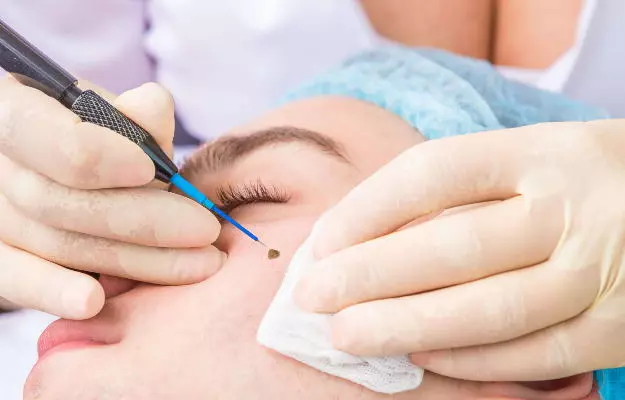Mole removal refers to treatment procedures employed for treating moles.
Mole (also called nevus) refers to small dark spots on the skin, usually tan or brown in colour. Every adult has moles; however, they may be removed for cosmetic reasons or to reduce the chances of skin cancer (melanoma).
The procedures are simple and day-care and a follow-up visit may be required.
- What is mole removal surgery
- Indications for mole removal surgery
- Contraindications to mole removal surgery
- Preparations before mole removal surgery
- What happens during mole removal surgery
- Risks and complications of mole removal
- Aftercare, Discharge and Follow-up
- Takeaway
What is mole removal surgery
There are various types of moles. Some moles may be present since birth while others may develop (acquired).
Mole removal refers to surgical procedures employed for removing moles. One should not rely on home remedies for removing moles as they are ineffective and might even be dangerous, causing scars, infections or spreading of cancerous cells (in case the mole contained them).
Benign moles can be removed by a primary care doctor. For more complicated cases, dermatologists and plastic surgeons need to be referred.
Indications for mole removal surgery
The following are the indications for mole removal:
- Indications for melanoma (ABCDE):
- Asymmetrical
- Borders are irregular
- The Colour is not uniform
- The Diameter is greater than a quarter of an inch
- Evolving or changing in size, colour or shape (especially change that is observable over a short time),
- Other indications for melanoma (a tumour associated with skin cancer):
- Inflamed and infected nodules
- Family history of skin cancer
- More than fifty moles on the body
- Irritation due to mole rubbing against or getting caught in clothing or jewellery
- Cosmetic reasons
Contraindications to mole removal surgery
There are no absolute contraindications to mole removal. Relative contraindications are the history of melanoma, recurrent mole, infection or allergies to anaesthesia.
Procedures involving radio waves are contraindicated for patients with a cardiac pacemaker.
In case carbon dioxide laser therapy is to be used, the following contraindications are applicable:
- Prior radiation therapy to the treatment area
- A user of certain medications like isotretinoin (used to treat severe acne and prevent certain skin cancers) in the past six months
- Bacterial infection or viral infection in the area to be treated
- History of scarring on wound healing
- Ongoing UV exposure
- Collagen vascular disease
- Prior procedures such as chemical peel or dermabrasion
Preparations before mole removal surgery
The person’s detailed history, including their family history, is taken with a focus on moles and melanomas. Other factors to be discussed are sun exposure and any perceived changes in moles.
A physical examination is carried out. This includes:
- Careful visual inspection of the moles. In some cases, the entire skin surface is examined
- Dimensions, location, colour, whether protruding, etc. are documented. For this, drawings of the lesion and an overall topographic chart may also be used
- Photographs and close views of the moles are particularly helpful for follow-ups
- Inspecting moles using dermoscopy
Besides the above, certain medications such as anticoagulants may be stopped prior to surgery and for a few days post-surgery as well.
What happens during mole removal surgery
The area to be treated will be cleaned with alcohol or povidone-iodine. Mole removal often involves local anaesthesia, though rarely general anaesthesia may also be administered.
After the anaesthesia has taken effect, a sterile drape could be placed over the area, although it may not be necessary. The following are the commonly followed approaches for mole removal:
- Shave biopsy: a scalpel is used to cut the mole and the surrounding border, using multiple horizontal cuts. The wound may be cauterized with a gentle electric current to prevent bleeding or apply a solution for the same. Alternatively, in the case of deep moles, stitches may also be used. This approach is more suitable for relatively small and non-cancerous moles.
- Punch biopsy: a special circular blade is placed perpendicular to the skin and rotated down using a twirling motion to puncture the area surrounding the mole. Once the penetration into the subcutaneous fat layer is made, the circular blade is removed. Stitches are usually required to close the wound.
- Excisional and incisional biopsy: if it is determined that the mole has developed deeper into the skin, an excisional or incisional biopsy may be carried out. In an excisional biopsy, the entire mole along with some normal tissue surrounding it is removed. An incisional biopsy involves removing a small area of the mole and not the entire area. Later, stitches are applied to close the wound.
- Laser therapy or radio waves may also be used for removing moles.
Risks and complications of mole removal
Mole removal usually does not result in complications. However, some of the risks are as follows:
- Infection if proper wound care is not done. The usual symptoms are redness, swelling, pain, and discharge from the wound.
- Nerve damage
- Allergy to anaesthesia
- Scar
- Recurring mole
In case of the following, the doctor needs to be promptly informed:
- Fever higher than 100°F in adults, 101°F in a child
- Severe pain that does not go away even after taking paracetamol (acetaminophen)
- Excessive bleeding, discharge or a foul smell from the wound.
Aftercare, Discharge and Follow-up
Mole removal is usually a daycare procedure. Discharge instructions include:
- Keeping a bandage on the wound for at least 24 to 48 hours
- Avoiding stress or strain on the operated area
- Cleaning the wound with water or a mild antiseptic solution
- After cleaning, applying petroleum jelly to maintain moisture and prevent the formation of scab and cover it with a bandage
Some bleeding may occur after the surgery which should subside by pressing the wound firmly with a sterile bandage for about half an hour.
The extracted mole tissue may be tested in the lab to rule out cancer. A follow-up may be scheduled to remove stitches and to check for signs of infection. Thereafter, an annual test is recommended.
Takeaway
Moles are of different types and hence it is important to keep a track of their colour, size, etc. on the body. Mole removal surgery is a straightforward minor procedure requiring local anaesthetic to remove the mole. It is carried out in case of cosmetic discomfort, irritation or to reduce the chances of skin cancer.
Various approaches to surgery are available. The surgery is carried out for cosmetic reasons or in case there are indications of melanoma. The biggest downside to mole removal is scarring. It is advisable to keep a track of moles and periodically self-inspecting them for any changes.
Doctors for Mole removal surgery

Dr. Ashish Mishra.
Dermatology
4 Years of Experience
Dr. Divyanshu Srivastava
Dermatology
10 Years of Experience

Dr. G.ARUN
Dermatology
6 Years of Experience
















